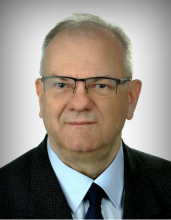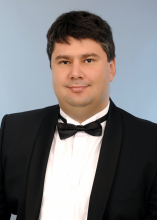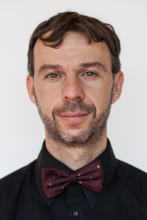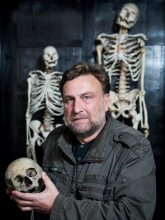Prof. Emer. Diedrich Graf von Keyserlingk
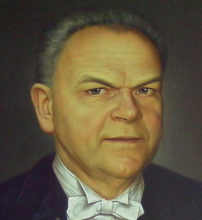
Department of Electron microscopy and Institute of Anatomy, Free University of Berlin; Institute of Anatomy, RWTH Aachen; Holder of DAAD Stipendium and Visiting Professor of Department of Histology and Embryology in Kaunas University of Medicine
PHYSICAL MORPHOLOGY OF THE HUMAN BRAIN
Fundamental features in the human brain are the molecular specify of nerve circuits and the topographic organization. Direct chemical contact of markers with the molecules is needed for identification the circuits. The topographic organization of polymers of the molecules may be evaluated by physical methods from distances. If the distance is far enough, the physical method may be applied even from outside of the person, which means patience in the living state. The anatomist and morphologist have the task to bridge the knowledge from the biochemical normal or pathological event to its physical appearance. Some morphologists concentrate on the biochemical part of the task other on the physical part with the bridging from inside to outside. The scientist in question belongs to the latter type. He was taught already as student by experiments in the department of electron microscopy to visualize biological tissues with an electron microscope - a quite new technique for medicine at that time. The kind of experiments and the kind of biological material in the department was free to decide for the interested student, everything was new. At that time (in the middle of the past century) freedom of research and teaching was the undisputed right and practice of universities and their scientists. The contract with the Head of Anatomy I, University Aachen in 1983 explicit claimed self-reliance of research and teaching. Indeed, electron microscopy in Aachen was replacing by CT (Computer Tomography) and MRT (Magnet Resonance Tomography) concentrating on clinical applications determined research activities was done from that time on. As bridging morphological between patience’s brain disturbance and consecutive CT and MRT images digital brain atlases were established. Already available stereotactic atlases were improved and applied. The anatomy of the white matter of the human brain became now quite better known as was some years ago, thanks to several new physical methods applying in brain research including the 3D-PLI (3D- Polarized Light Imaging). The interpretation of the patience`s disturbance by physical images cannot be done in simple way because simple linear dependencies do not exist. New concepts like fuzzy logic and artificial intelligence have to be applied. For more details the special publications should be consulted. While 3D-PLI took an impressive worldwide development and improvement, the microwave measurements of brain tissue for its identification did not. Perhaps this idea will also get a future.
MORE ABOUT THE SCIENTIST
In 1970, prof. Graf von Keyserlingk performed the first electron microscopic visualization of contractile filaments in the mammalian non-muscular cells by glycerin-extraction and ATP-contraction. In 1998, he also identified the three-dimensional orientation of myelinated nerve fiber and collagen fiber tracts by polarization light. In 1999-2002, prof. Graf von Keyserlingk completed the microwave dielectric measurements in tissues localizing in the human brain. Prof. Graf von Keyserlingk is one of the first researchers who applied in studies stereology (Weibel), image processing, fuzzy logic and artificial intelligence (Kohonen). He is the author of 148 scientific publications, nine textbooks for medical students and specialists and has over 1700 citations since 1977. Prof. Diedrich Graf von Keyserlingk was supported by Grant from Europe AIM, Project N 2003 COVIRA (COmputer VIsion in Radiology) that had the final task – to create the Digital Anatomy Atlas.
Department of Electron microscopy and Institute of Anatomy, Free University of Berlin; Institute of Anatomy, RWTH Aachen; Holder of DAAD Stipendium and Visiting Professor of Department of Histology and Embryology in Kaunas University of Medicine
PHYSICAL MORPHOLOGY OF THE HUMAN BRAIN
Fundamental features in the human brain are the molecular specify of nerve circuits and the topographic organization. Direct chemical contact of markers with the molecules is needed for identification the circuits. The topographic organization of polymers of the molecules may be evaluated by physical methods from distances. If the distance is far enough, the physical method may be applied even from outside of the person, which means patience in the living state. The anatomist and morphologist have the task to bridge the knowledge from the biochemical normal or pathological event to its physical appearance. Some morphologists concentrate on the biochemical part of the task other on the physical part with the bridging from inside to outside. The scientist in question belongs to the latter type. He was taught already as student by experiments in the department of electron microscopy to visualize biological tissues with an electron microscope - a quite new technique for medicine at that time. The kind of experiments and the kind of biological material in the department was free to decide for the interested student, everything was new. At that time (in the middle of the past century) freedom of research and teaching was the undisputed right and practice of universities and their scientists. The contract with the Head of Anatomy I, University Aachen in 1983 explicit claimed self-reliance of research and teaching. Indeed, electron microscopy in Aachen was replacing by CT (Computer Tomography) and MRT (Magnet Resonance Tomography) concentrating on clinical applications determined research activities was done from that time on. As bridging morphological between patience’s brain disturbance and consecutive CT and MRT images digital brain atlases were established. Already available stereotactic atlases were improved and applied. The anatomy of the white matter of the human brain became now quite better known as was some years ago, thanks to several new physical methods applying in brain research including the 3D-PLI (3D- Polarized Light Imaging). The interpretation of the patience`s disturbance by physical images cannot be done in simple way because simple linear dependencies do not exist. New concepts like fuzzy logic and artificial intelligence have to be applied. For more details the special publications should be consulted. While 3D-PLI took an impressive worldwide development and improvement, the microwave measurements of brain tissue for its identification did not. Perhaps this idea will also get a future.
MORE ABOUT THE SCIENTIST
In 1970, prof. Graf von Keyserlingk performed the first electron microscopic visualization of contractile filaments in the mammalian non-muscular cells by glycerin-extraction and ATP-contraction. In 1998, he also identified the three-dimensional orientation of myelinated nerve fiber and collagen fiber tracts by polarization light. In 1999-2002, prof. Graf von Keyserlingk completed the microwave dielectric measurements in tissues localizing in the human brain. Prof. Graf von Keyserlingk is one of the first researchers who applied in studies stereology (Weibel), image processing, fuzzy logic and artificial intelligence (Kohonen). He is the author of 148 scientific publications, nine textbooks for medical students and specialists and has over 1700 citations since 1977. Prof. Diedrich Graf von Keyserlingk was supported by Grant from Europe AIM, Project N 2003 COVIRA (COmputer VIsion in Radiology) that had the final task – to create the Digital Anatomy Atlas.

